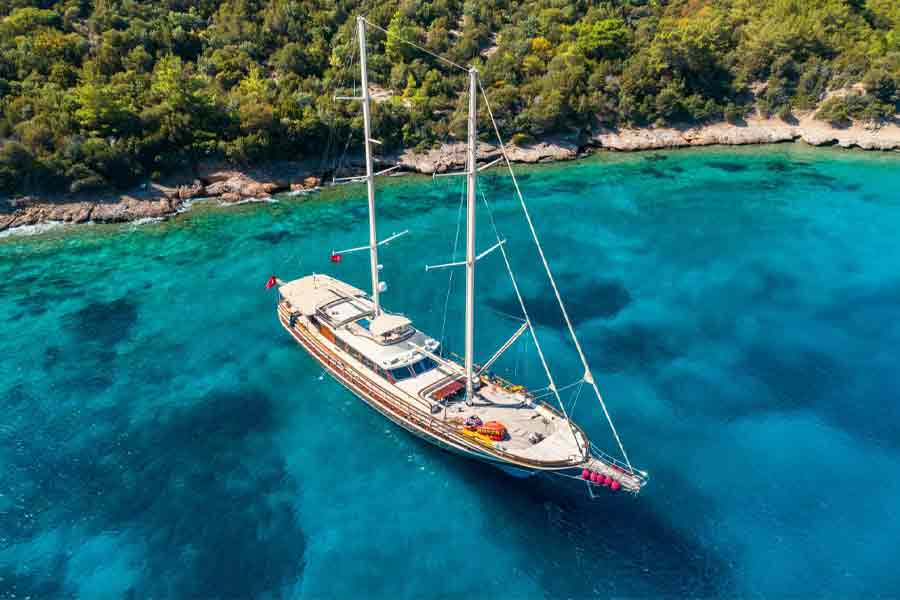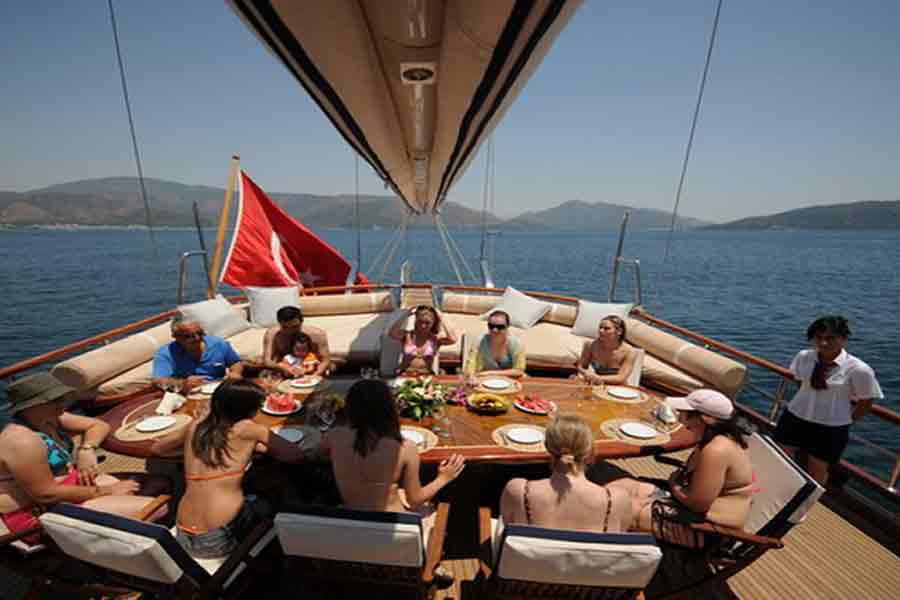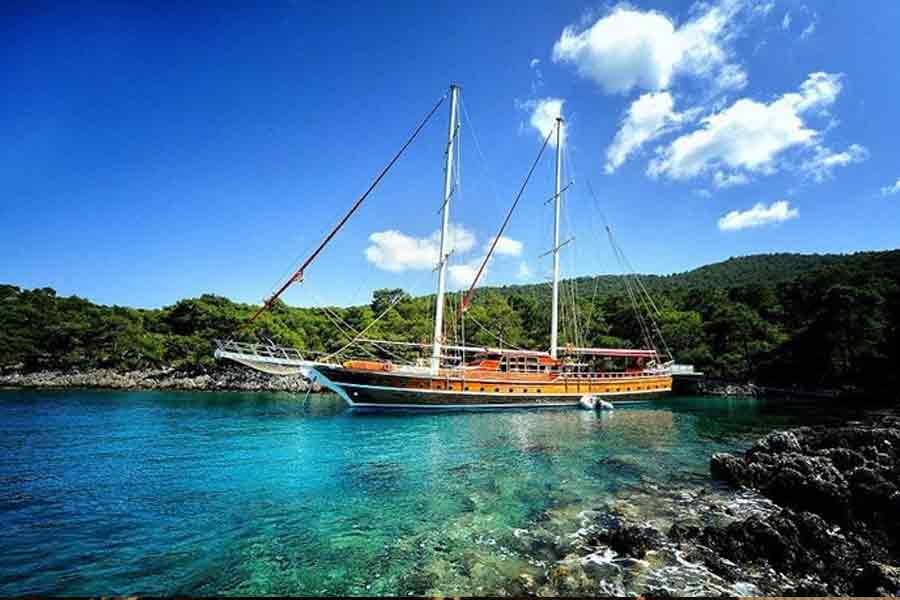Historical ruins, beautiful beaches, sleepy fishing villages and world class marinas make gulet cruising in Turkey an experience no other country in the world can replicate. Cruising the Turkish Riviera is not a new phenomenon, but it never appealed to mainstream holiday markets until the last decade when the Internet shifted people’s perception of travel.
Pre 2000, holidaymakers relied on travel agents to plan itineraries; but they now embark on independent forms of travel including gulet cruises around Turkey’s stunning coastlines.
What is a Gulet in Turkey?
When you book gulet sailing holidays in Turkey, you are venturing into an age-old nautical tradition. Gulets are traditional, handcrafted wooden boats with two or three masts. Although other countries such as Italy, Montenegro, and Croatia, use gulets, Turkey has an esteemed and long-established reputation for making gulet boats, especially in Bodrum and Bozburun, two coastal hubs on the west and southwest coast.
Their original use was for sponge diving and fishing, but over the years, the concept has evolved to become overnight floating hotels. Esteemed professionals expertly handcraft each gulet boat with unique design and décor. You can find more information about gulet boats here.
Where to take a Gulet Cruise in Turkey
The most popular places in Turkey to take a gulet cruise are around the Gulf of Gökova, usually departing from the historic city of Bodrum, and along the Lycian (Turquoise) Coast, from towns such as Marmaris and Fethiye. Once you’re comfortably settled aboard, days are spent traveling sedately along the coast, or between islands. In the evenings you’ll moor up either in a quiet bay which perhaps your captain is one of the few people that knows, or in a busier harbour where you can pop ashore to eat in a local restaurant.
Because gulets are small, often limited to around 17 passengers, they can reach places that larger cruise ships cannot. Even in the height of summer, then, it’s possible to find a remote and peaceful beach or snorkeling spot with no one else for miles around.
How to get to the Turquoise Coast
Depending on which direction you want to sail in, you need to fly to Fethiye or Antalya. Turkish Airlines and Pegasus both fly domestically from Istanbul and several other Turkish destinations to these seaside ports. You can also reach these towns by bus or train, which you can read more about in my guide to using public transport in Turkey.
From the UK or other European destinations, in the summer months (April to October), many airlines fly to Fethiye or Antalya and you should be able to catch a good deal.
When is the best time to go sailing in Turkey
For prime weather conditions, the peak summer season from May to September is best. In these months, the crowds do swell but the weather is best and you can almost guarantee long, sunny, hoy days – perfect for sailing trips in Turkey!
Why Charter a Gulet with Crew in Turkey
Exclusively renting a crewed sailing yacht allows you to choose your itinerary, like the stages of a real tour, and to indulge your desires and your times.
Opting for the rental of a gulet with exclusive crew is ideal for a group of friends or for families with children: each gulet generally has 5 or more double cabins with private bathroom and the large size of the boat (the most common size is about 20/25 meters) allow a pleasant travel experience where everyone can enjoy their privacy.
Experience the taste of yesteryear of a gulet cruise: you will have the feeling of living a legendary adventure ... ideal for a group of friends, unforgettable for a vacation with children!
The rental of a gulet in Turkey is perfect for those seeking a slow pace, comfort and relaxation as well as views of rare beauty, in a nutshell the luxury at an affordable price: a crew at your service, ample space on deck, cabins and cozy interior spaces and comfortable sundecks make your choice a premium vacation Sailsquare.
Enjoy a vacation in a gulet (from the Turkish kayık, "boat") sailing on the routes of Turkey, the home of this characteristic boat: wooden, two masts, flat keel of the hull that allows you to reach shallow bays, more space and livability.
Cruising Hubs in Turkey: Antalya, Marmaris, Fethiye, Bodrum

The Turquoise coast stretches from the northern Aegean to the eastern Mediterranean. Winding its way from West to South, it comprises over fifty small bays and villages and many ancient ruins that add a twist to cruising the Aegean and the Mediterranean Sea. Passengers put together itineraries depending on historical sites or Turkish coastal resorts they want to see. They also follow established Blue Voyage routes. Out of all the coastal hubs, four emerged as major destinations.
Bodrum: As the heart of where it all began, Bodrum’s reputation stems worldwide as an expert in gulet cruises, private yachts charters, and sailing holidays. The peninsula comprises a major town centre and smaller coastal resorts that do luxury in style, as often seen in substantial mega yachts docked into bays. Out of all the seaside resorts, Yalikavak has shot to yachting fame because of its mega yacht marina.
Fethiye: While Bodrum does luxury in style, Lycian Fethiye attracts budget holidaymakers with low cost, three-night trips to Olympos, further east along the coastline. This blue voyage route takes in many delights like Fethiye’s twelve islands, Oludeniz and the Blue Lagoon, the prestigious resort of Kalkan, and Kekova sunken ruins.
Marmaris: As a pioneer of Turkey’s tourism industry, international sailors have always favoured Marmaris. During summer, cruises depart from the harbour area to cruise around the coastline to visit hidden coves, off the track islands, and beautiful beaches.
Antalya: The eastern Mediterranean is home to Antalya, the second most popular holiday destination. Antalya’s reputation for top-notch hospitality also wins it rave reviews from the yachting world. Even just sailing the Antalya coastline delights everyone as excursions to attractions like Mount Tahtali, Aspendos and Chimaera’s burning flames make every day different.






